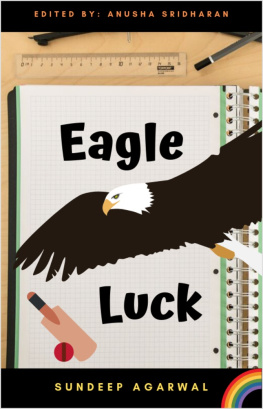Sundeep Agarwal - Vim Reference Guide
Here you can read online Sundeep Agarwal - Vim Reference Guide full text of the book (entire story) in english for free. Download pdf and epub, get meaning, cover and reviews about this ebook. year: 2022, publisher: Leanpub, genre: Home and family. Description of the work, (preface) as well as reviews are available. Best literature library LitArk.com created for fans of good reading and offers a wide selection of genres:
Romance novel
Science fiction
Adventure
Detective
Science
History
Home and family
Prose
Art
Politics
Computer
Non-fiction
Religion
Business
Children
Humor
Choose a favorite category and find really read worthwhile books. Enjoy immersion in the world of imagination, feel the emotions of the characters or learn something new for yourself, make an fascinating discovery.

- Book:Vim Reference Guide
- Author:
- Publisher:Leanpub
- Genre:
- Year:2022
- Rating:3 / 5
- Favourites:Add to favourites
- Your mark:
- 60
- 1
- 2
- 3
- 4
- 5
Vim Reference Guide: summary, description and annotation
We offer to read an annotation, description, summary or preface (depends on what the author of the book "Vim Reference Guide" wrote himself). If you haven't found the necessary information about the book — write in the comments, we will try to find it.
Vim Reference Guide — read online for free the complete book (whole text) full work
Below is the text of the book, divided by pages. System saving the place of the last page read, allows you to conveniently read the book "Vim Reference Guide" online for free, without having to search again every time where you left off. Put a bookmark, and you can go to the page where you finished reading at any time.
Font size:
Interval:
Bookmark:
Sundeep Agarwal
Vim Reference Guide is intended as a concise learning resource for beginner to intermediate level Vim users. It has more in common with cheatsheets than a typical text book. Most features are presented using a sample usage. Topics like Regular Expressions and Macros have more detailed explanations and examples due to their complexity.
The features covered in this guide are shaped and limited by my own experiences since 2007. Fourteen years would seem a long time to have already become an expert, but I'm not there yet (nor do I have a pressing need for such expertise). The earlier version of this guide was written five years back and I still took more than three months to get it fit for publication. A large portion of that time was spent correcting my understanding of Vim commands, going through user and reference manuals, getting good at using built-in help, learning more features and so on.
I do give a brief introduction to get started with using Vim, but having prior experience would be ideal before using this resource. As a minimum requirement, you should be able to use vimtutor on your own.

- This guide is based on Vim version 8.1 and some instructions assume Unix/Linux like operating system. Where possible, details and resources are mentioned for other platforms.
- I prefer using GVim, so you might find some differences if you are using Vim.
- Built-in help command examples are also linked to an online version. For example, clicking :h usr_toc.txt will take you to table of contents for Vim User Manual. :h usr_toc.txt is also a command that you can use from within Vim.
- External links are provided throughout the book for exploring some topics in more depth.
- vim_reference repo has markdown source and other details related to the book. If you are not familiar with
gitcommand, click the Code button on the webpage to get the files.
- Since many chapters take the form of cheatsheet with examples, this is a densely packed guide. Feel free to skim read some sections (because you already know them, not applicable for your use cases, etc), but try not to skip them entirely.
- If you are not able to understand a particular feature, go through the Vim user manual for that topic first. Each chapter has related documentation links at the top and external learning resources are often mentioned at the end of command descriptions.
- Practice the commands multiple times to build muscle memory.
- Building your own cheatsheet is highly recommended. You wouldn't need to refer most of the basic commands often, so you'll end up with a manageable reference sheet. As you continue to build muscle memory, you can prune the cheatsheet further.
- This guide covers a lot, but not everything. So, you'll need to learn from other resources too and add to your personal cheatsheet.
- Vim help files user and reference manuals
- /r/vim/ and vi.stackexchange helpful forums
- canva cover image
- Warning and Info icons by Amada44 under public domain
- oxipng, pngquant and svgcleaner for optimizing images
- Rodrigo Giro Serro for feedback and suggestions
- Andy for cover image suggestions
I would highly appreciate if you'd let me know how you felt about this book, it would help to improve this book as well as my future attempts. Also, please do let me know if you spot any error or typo.
Issue Manager: https://github.com/learnbyexample/vim_reference/issues
E-mail:
Twitter: https://twitter.com/learn_byexample
Sundeep Agarwal is a lazy being who prefers to work just enough to support his modest lifestyle. He accumulated vast wealth working as a Design Engineer at Analog Devices and retired from the corporate world at the ripe age of twenty-eight. Unfortunately, he squandered his savings within a few years and had to scramble trying to earn a living. Against all odds, selling programming ebooks saved his lazy self from having to look for a job again. He can now afford all the fantasy ebooks he wants to read and spends unhealthy amount of time browsing the internet.
When the creative muse strikes, he can be found working on yet another programming ebook (which invariably ends up having at least one example with regular expressions). Researching materials for his ebooks and everyday social media usage drowned his bookmarks, so he maintains curated resource lists for sanity sake. He is thankful for free learning resources and open source tools. His own contributions can be found at https://github.com/learnbyexample.
List of books: https://learnbyexample.github.io/books/
This work is licensed under a Creative Commons Attribution-NonCommercial-ShareAlike 4.0 International License
Code snippets are available under MIT License
Resources mentioned in Acknowledgements section above are available under original licenses.
1.0
See Version_changes.md to track changes across book versions.
Back in 2007, I had a rough beginning as a design engineer at a semiconductor company in terms of software tools. Linux command line, Vim and Perl were all new to me. I distinctly remember progressing from dd (delete current line) to d (delete current line as well as the line below) and feeling happy that it reduced time spent on editing. Since I was learning on the job, I didn't know about count prefix or the various ways I could've deleted all the lines from the beginning of the file to the line containing a specific phrase. Or even better, I could've automated editing multiple files if I had been familiar with sed or progressed that far with Perl.
I also remember that we got a two-sided printed cheatsheet that we kept pinned to our cabins. That was one of the ways I kept adding commands to my repertoire. But, I didn't have a good insight to Vim's philosophy and I didn't know how to apply many of the cheatsheet commands. At some point, I decided to read the Vim book by Steve Oualline and that helped a lot, but it was also too long and comprehensive for me to read it all. My memory is hazy after that, and I don't recall what other resources I used. However, I'm sure I didn't effectively utilize built-in help. Nor did I know about stackoverflow or /r/vim until after I left my job in 2014.
Still, I knew enough to conduct a few Vim learning sessions for my colleagues. That came in handy when I got chances to teach Vim as part of scripting course for college students. From 2016 to 2018, I started maintaining my tutorials on Linux command line, Vim and scripting languages as GitHub repos. As you might guess, I then started polishing these materials and published them as ebooks. This is an ongoing process, with Vim Reference Guide being the twelfth ebook.
You've probably already heard that Vim is a text editor, powerful one at that. Vim's editing features feel like a programming language and you can customize the editor using scripting languages. Apart from plethora of editing commands and support for regular expressions, you can also incorporate external commands. To sum it up, most editing tasks can be managed from within Vim itself instead of having to write a script.
Font size:
Interval:
Bookmark:
Similar books «Vim Reference Guide»
Look at similar books to Vim Reference Guide. We have selected literature similar in name and meaning in the hope of providing readers with more options to find new, interesting, not yet read works.
Discussion, reviews of the book Vim Reference Guide and just readers' own opinions. Leave your comments, write what you think about the work, its meaning or the main characters. Specify what exactly you liked and what you didn't like, and why you think so.


